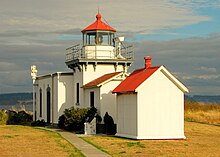Point No Point Light (Washington)
 |
|
| Location | Hansville, Washington |
|---|---|
| Coordinates | 47°54′44″N 122°31′36″W / 47.9123°N 122.5268°WCoordinates: 47°54′44″N 122°31′36″W / 47.9123°N 122.5268°W |
| Year first constructed | 1879 |
| Year first lit | 1880 |
| Foundation | Masonry |
| Construction | Brick and stucco |
| Tower shape | Square |
| Height | 30 feet (9.1 m) |
| Focal height | 27 feet (8.2 m) |
| Original lens | Fifth order Fresnel lens (1880); Fourth order Fresnel lens (1898) |
| Characteristic | 3 white flashes every 10 s |
| Heritage | place listed on the National Register of Historic Places |
|
Point No Point Light Station
|
|
 |
|
| Nearest city | Hansville, Washington |
| Area | 3 acres (1.2 ha) |
| Built | 1879-80 |
| NRHP Reference # | 78002758 |
| Added to NRHP | August 10, 1978 |
|
[]
|
|
Point No Point Light is an operational aid to navigation on the northeastern tip of the Kitsap Peninsula on the west side of Puget Sound, at Point No Point where Admiralty Inlet joins Puget Sound, near the small community of Hansville, Kitsap County, in the U.S. state of Washington. Point No Point Light is considered the oldest lighthouse on Puget Sound and is listed on the National Register of Historic Places.
Local authorities first proposed to locate the lighthouse further north on Foulweather Bluff. When the Point No Point location was agreed upon, the owners of the land were reluctant to sell. The terms of the final sales agreement have been variously reported as 10 acres (4.0 ha) for $1,000, 40 acres (16 ha) for $1,000, and 40 acres (16 ha) for $1,800.
Construction of the lighthouse began in April 1879. The first light used was a kerosene lamp. As 1879 drew to a close, the lens and glass for the lantern had not arrived, so the first lighthouse keeper, J.S. Maggs, a Seattle dentist, hung a canvas over the south window openings to break the wind and keep the kerosene lamp from blowing out.
Upon completion of the light station in February 1880, the lantern room held a fifth-order Fresnel lens. The original masonry structure was 27 feet (8.2 m) high. The present 30-foot (9.1 m) brick and stucco tower is square and situated between the office and fog signal building. A fog signal, formerly used at New Dungeness Lighthouse, was installed in April 1880. In 1900, the fog bell was replaced by a Daboll trumpet. With no roads to the lighthouse for its first 40 years, supplies had to be brought in by boat.
...
Wikipedia


